
The New York City Landmarks Preservation Commission (LPC) is the New York City agency charged with administering the city's Landmarks Preservation Law. The LPC is responsible for protecting New York City's architecturally, historically, and culturally significant buildings and sites by granting them landmark or historic district status, and regulating them after designation. It is the largest municipal preservation agency in the nation. As of July 1, 2020, the LPC has designated more than 37,000 landmark properties in all five boroughs. Most of these are concentrated in historic districts, although there are over a thousand individual landmarks, as well as numerous interior and scenic landmarks.
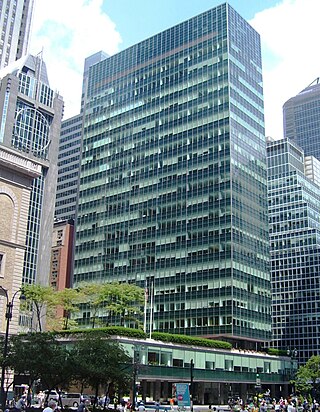
Lever House is a 307-foot-tall (94 m) office building at 390 Park Avenue in the Midtown Manhattan neighborhood of New York City. The building was designed in the International Style by Gordon Bunshaft and Natalie de Blois of Skidmore, Owings & Merrill (SOM) as the headquarters of soap company Lever Brothers, a subsidiary of Unilever. Constructed from 1950 to 1952, it was the second skyscraper in New York City with a glass curtain wall, after the United Nations Secretariat Building.

McCarren Park is a public park in Brooklyn, New York City. It is located on the border of Williamsburg and Greenpoint and is bordered by Nassau Avenue, Bayard Street, Lorimer Street and North 12th Street. The park contains facilities for recreational softball, volleyball, soccer, handball, and other games. It is also used for sunbathing and dog-walking. It also includes the McCarren Play Center, which consists of a recreation center and a pool. McCarren Park is maintained by the New York City Department of Parks and Recreation.
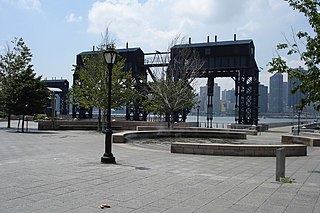
Gantry Plaza State Park is a 12-acre (4.9 ha) state park on the East River in the Hunters Point section of Long Island City, in the New York City borough of Queens. The park is located in a former dockyard and manufacturing district, and includes remnants of facilities from the area's past. The most prominent feature of the park is a collection of gantries with car float transfer bridges, which in turn were served by barges that carried freight railcars between Queens and Manhattan.

The TWA Flight Center, also known as the Trans World Flight Center, is an airport terminal and hotel complex at New York City's John F. Kennedy International Airport (JFK). The original terminal building, or head house, operated as a terminal from 1962 to 2001 and was adaptively repurposed in 2017 as part of the TWA Hotel. The head house is partially encircled by a replacement terminal building completed in 2008, as well as by the hotel buildings. The head house and replacement terminal collectively make up JetBlue's JFK operations and are known as Terminal 5 or T5.

New York City's Theater District, sometimes spelled Theatre District and officially zoned as the "Theater Subdistrict", is an area and neighborhood in Midtown Manhattan where most Broadway theaters are located, in addition to other theaters, movie theaters, restaurants, hotels, and other places of entertainment. It is bounded by West 40th Street on the south, West 54th Street on the north, Sixth Avenue on the east and Eighth Avenue on the west, and includes Times Square. The Great White Way is the name given to the section of Broadway which runs through the Theater District.
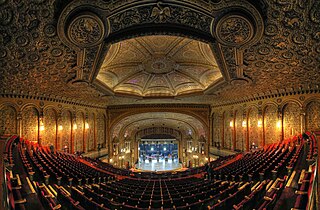
The United Palace is a theater at 4140 Broadway in the Washington Heights neighborhood of Manhattan in New York City. The theater, occupying a full city block bounded by Broadway, Wadsworth Avenue, and West 175th and 176th Streets, functions both as a spiritual center and as a nonprofit cultural and performing arts center. Architect Thomas W. Lamb designed the theater as a movie palace, which opened in 1930 as one of five Loew's Wonder Theatres in the New York City area. The theater's lavishly eclectic interior decor was supervised by Harold Rambusch, who also designed the interior of the Roxy Theatre and the Waldorf-Astoria Hotel.

The IRT Powerhouse, also known as the Interborough Rapid Transit Company Powerhouse, is a former power station of the Interborough Rapid Transit Company (IRT), which operated the New York City Subway's first line. The building fills a block bounded by 58th Street, 59th Street, Eleventh Avenue, and Twelfth Avenue in the Hell's Kitchen and Riverside South neighborhoods of Manhattan.

The Forest Park Carousel is a historic carousel at Forest Park in Queens, New York City. The carousel, one of two known surviving carousels built by Daniel Carl Muller, was built c. 1903 and contains 52 figures and its original band organ. Originally located in Dracut, Massachusetts, the carousel was relocated to Forest Park in 1972, replacing an earlier carousel on the site. The ride, operated by NY Carousel since 2012, is part of a seasonal amusement center called Forest Park Carousel Amusement Village. The Forest Park Carousel was listed on the National Register of Historic Places in 2004 and has been a New York City designated landmark since 2013.

The RKO Keith's Theater was an RKO Pictures movie theater at 129-43 Northern Boulevard in the Flushing neighborhood of Queens in New York City. It was designed by architect Thomas W. Lamb and built in 1928. While the RKO Keith's had a plain three-story facade, its interior was elaborately designed in a Spanish Baroque Revival style. The theater had a square ticket lobby and an oval grand foyer, which led to the double-level auditorium. The auditorium was designed as an atmospheric theater with a blue ceiling and gilded-plaster decorations; it contained 2,974 seats across two levels. There were also four lounges and a mezzanine promenade.

Anable Basin is a 500-foot-long (150 m) artificial inlet of the East River located in the Long Island City neighborhood of Queens, New York City. It was carved in 1868 to serve the large concentrations of industrial firms in the neighborhood.

Sven is a residential building located at 29-27 Queens Plaza North in the Long Island City neighborhood of Queens, New York City. At 755 feet (230 m) tall, Sven is the second-tallest building in Queens behind Skyline Tower, as well as one of the tallest buildings in New York City outside of Manhattan.

44 Union Square, also known as 100 East 17th Street and the Tammany Hall Building, is a three-story building at 44 Union Square East in Union Square, Manhattan, in New York City. It is at the southeast corner of Union Square East/Park Avenue South and East 17th Street. The neo-Georgian structure was erected in 1928–1929 and designed by architects Thompson, Holmes & Converse and Charles B. Meyers for the Tammany Society political organization, also known as Tammany Hall. It is the organization's oldest surviving headquarters building.
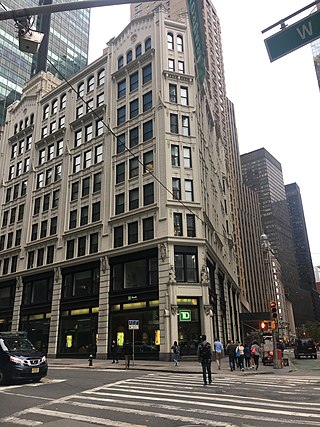
224 West 57th Street, also known as the Argonaut Building and formerly as the Demarest and Peerless Company Building, is a commercial building on the southeast corner of Broadway and 57th Street in Midtown Manhattan, New York City, just south of Columbus Circle. The building consists of two formerly separate structures, the A. T. Demarest & Company Building and the Peerless Motor Car Company Building, both used by automobile companies. Both structures were designed by Francis H. Kimball and erected by the George A. Fuller Company with similar Gothic Revival and Romanesque Revival architectural details.
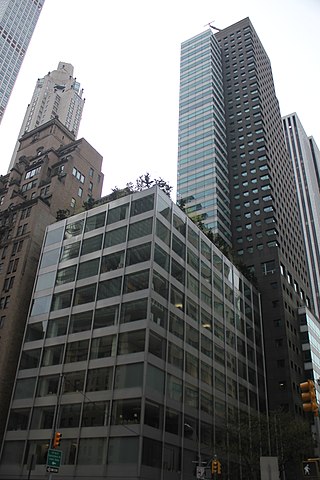
500 Park Avenue is an office and condominium building on the southwest corner of Park Avenue and 59th Street in the Midtown Manhattan neighborhood of New York City, composed of the 11-story Pepsi-Cola Building and the 40-story 500 Park Tower. The original Pepsi-Cola Building along Park Avenue was constructed from 1958 to 1960 and designed by Gordon Bunshaft and Natalie de Blois of Skidmore, Owings and Merrill (SOM). The tower along 59th Street was constructed between 1981 and 1984 to designs by James Stewart Polshek & Partners.

1552 Broadway, also known as the I. Miller Building, is a commercial structure on Times Square in the Theater District of Midtown Manhattan in New York City. Located at the northeast corner of Broadway and 46th Street, the building was designed by Louis H. Friedland, with sculptures by Alexander Stirling Calder. The current building, designed for shoe retailer I. Miller, dates to 1926 and was combined from two 19th-century brownstone residences on the site. It contains decorative elements from several styles.
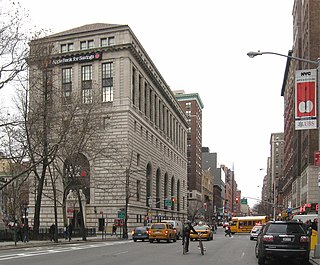
The Apple Bank Building, also known as the Central Savings Bank Building and 2100 Broadway, is a bank and residential building at 2100–2114 Broadway on the Upper West Side of Manhattan in New York City. Constructed as a branch of the Central Savings Bank from 1926 to 1928, it occupies a trapezoidal city block bounded by 73rd Street to the south, Amsterdam Avenue to the east, 74th Street to the north, and Broadway to the west. The Apple Bank Building was designed by York and Sawyer in the Renaissance Revival and palazzo styles, patterned after an Italian Renaissance-style palazzo.

The Vanderbilt Family Cemetery and Mausoleum is a private burial site within the Moravian Cemetery in the New Dorp neighborhood of Staten Island, New York City. It was designed by Richard Morris Hunt and Frederick Law Olmsted in the late 19th century, when the Vanderbilt family was the wealthiest in America.




















